高中英语语法之状语从句
- 格式:ppt
- 大小:692.00 KB
- 文档页数:52
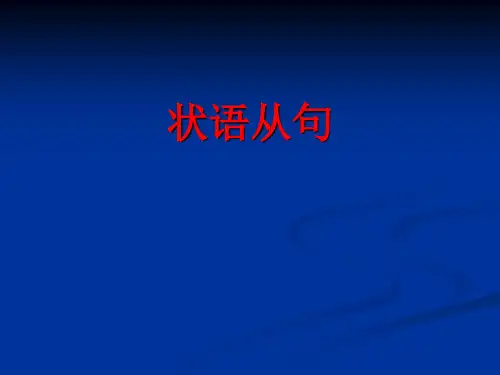

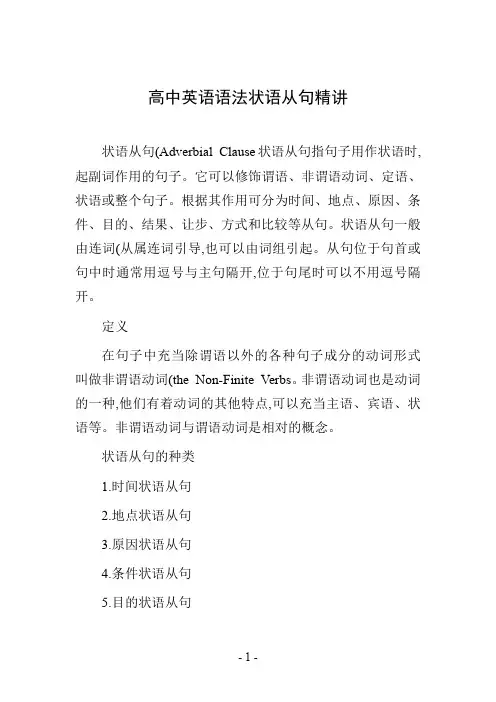
高中英语语法状语从句精讲状语从句(Adverbial Clause状语从句指句子用作状语时,起副词作用的句子。
它可以修饰谓语、非谓语动词、定语、状语或整个句子。
根据其作用可分为时间、地点、原因、条件、目的、结果、让步、方式和比较等从句。
状语从句一般由连词(从属连词引导,也可以由词组引起。
从句位于句首或句中时通常用逗号与主句隔开,位于句尾时可以不用逗号隔开。
定义在句子中充当除谓语以外的各种句子成分的动词形式叫做非谓语动词(the Non-Finite Verbs。
非谓语动词也是动词的一种,他们有着动词的其他特点,可以充当主语、宾语、状语等。
非谓语动词与谓语动词是相对的概念。
状语从句的种类1.时间状语从句2.地点状语从句3.原因状语从句4.条件状语从句5.目的状语从句6.让步状语从句7.比较状语从句8.方式状语从句9.结果状语从句状语从句的时态特点一般情况下,时间和条件状语从句的谓语动词一般用“一般现在时”表示“一般将来时”,用“现在完成时”表示“将来完成时”。
例如:I will call you as soon as I arrive in Beijing.我到北京就将给你打电话。
(这是由as soon as引导的时间状语从句,从句中的谓语动词arrive是一般现在时,表示一般将来时,决不可用will arrive As soon as I have finished this work,I will go home.我一完成此工作,就回家。
(从句中的谓语动词用现在完成时have finished,表示将来完成时,决不可用will h ave finishedIf he comes back,please let me know.如果他回来了,请通知我。
(从句中的谓语动词用comes back,表示一般将来时,决不可用will come back状语从句讲解和练习状语修饰动词、形容词、副词或整个句子。
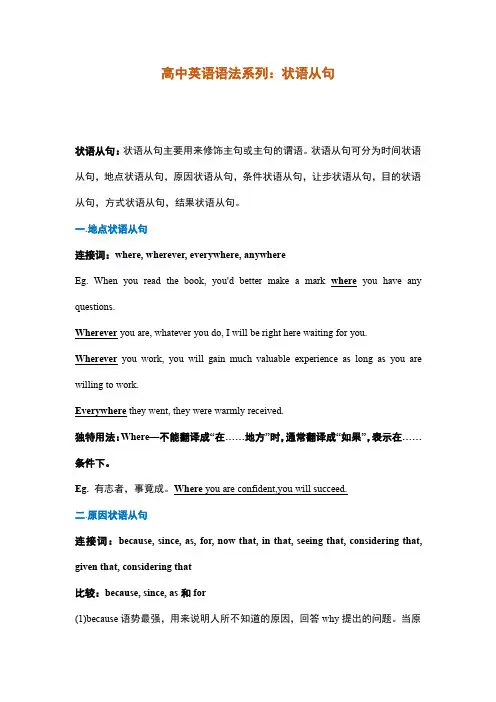
高中英语语法系列:状语从句状语从句:状语从句主要用来修饰主句或主句的谓语。
状语从句可分为时间状语从句,地点状语从句,原因状语从句,条件状语从句,让步状语从句,目的状语从句,方式状语从句,结果状语从句。
一.地点状语从句连接词:where,wherever,everywhere,anywhereEg.When you read the book,you'd better make a mark where you have any questions.Wherever you are,whatever you do,I will be right here waiting for you. Wherever you work,you will gain much valuable experience as long as you are willing to work.Everywhere they went,they were warmly received.独特用法:Where—不能翻译成“在……地方”时,通常翻译成“如果”,表示在……条件下。
Eg.有志者,事竟成。
Where you are confident,you will succeed.二.原因状语从句连接词:because,since,as,for,now that,in that,seeing that,considering that, given that,considering that比较:because,since,as和for(1)because语势最强,用来说明人所不知道的原因,回答why提出的问题。
当原因是显而易见的或已为人们所知,就用since或asEg.Mr.Zhang disliked me because I'm handsome and rich.Since/As the weather is so bad,we have to delay our journey.(2)由because引导的从句如果放在句末,且前面有逗号,则可用for代替。
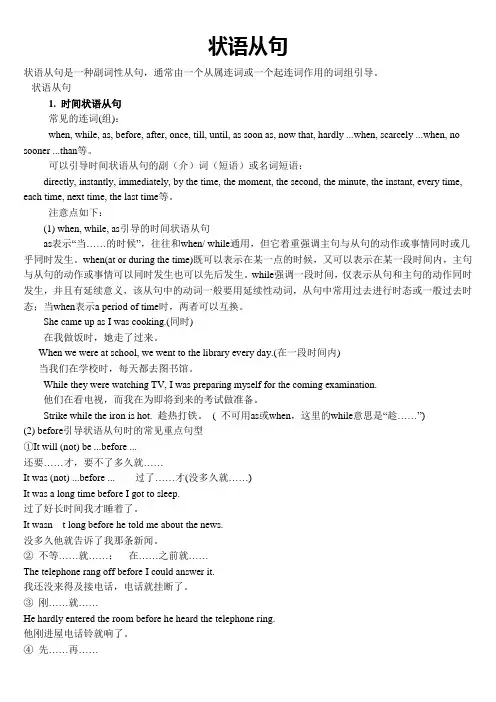
状语从句状语从句是一种副词性从句,通常由一个从属连词或一个起连词作用的词组引导。
状语从句1. 时间状语从句常见的连词(组):when, while, as, before, after, once, till, until, as soon as, now that, hardly ...when, scarcely ...when, no sooner ...than等。
可以引导时间状语从句的副(介)词(短语)或名词短语:directly, instantly, immediately, by the time, the moment, the second, the minute, the instant, every time, each time, next time, the last time等。
注意点如下:(1) when, while, as引导的时间状语从句as表示“当……的时候”,往往和when/ while通用,但它着重强调主句与从句的动作或事情同时或几乎同时发生。
when(at or during the time)既可以表示在某一点的时候,又可以表示在某一段时间内,主句与从句的动作或事情可以同时发生也可以先后发生。
while强调一段时间,仅表示从句和主句的动作同时发生,并且有延续意义,该从句中的动词一般要用延续性动词,从句中常用过去进行时态或一般过去时态;当when表示a period of time时,两者可以互换。
She came up as I was cooking.(同时)在我做饭时,她走了过来。
When we were at school, we went to the library every day.(在一段时间内)当我们在学校时,每天都去图书馆。
While they were watching TV, I was preparing myself for the coming examination.他们在看电视,而我在为即将到来的考试做准备。

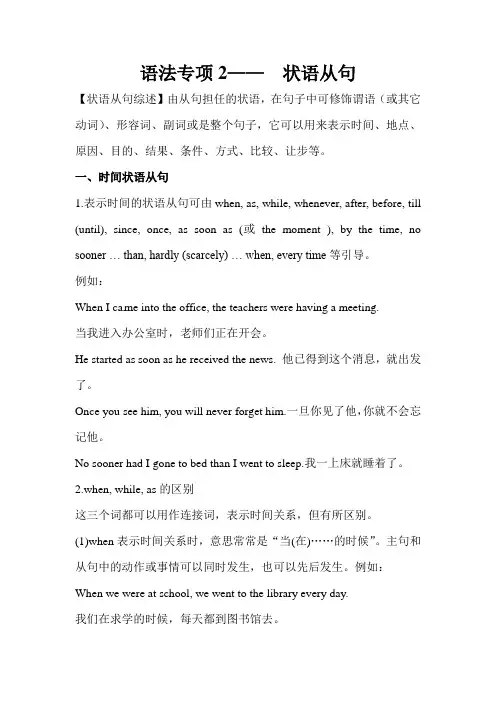
语法专项2——状语从句【状语从句综述】由从句担任的状语,在句子中可修饰谓语(或其它动词)、形容词、副词或是整个句子,它可以用来表示时间、地点、原因、目的、结果、条件、方式、比较、让步等。
一、时间状语从句1.表示时间的状语从句可由when, as, while, whenever, after, before, till (until), since, once, as soon as (或the moment ), by the time, no sooner … than, hardly (scarcely) … when, every time等引导。
例如:When I came into the office, the teachers were having a meeting.当我进入办公室时,老师们正在开会。
He started as soon as he received the news. 他已得到这个消息,就出发了。
Once you see him, you will never forget him.一旦你见了他,你就不会忘记他。
No sooner had I gone to bed than I went to sleep.我一上床就睡着了。
2.when, while, as的区别这三个词都可以用作连接词,表示时间关系,但有所区别。
(1)when表示时间关系时,意思常常是“当(在)……的时候”。
主句和从句中的动作或事情可以同时发生,也可以先后发生。
例如:When we were at school, we went to the library every day.我们在求学的时候,每天都到图书馆去。
(2)while 用作连接词表示时间关系时,意思也是“当(在)……的时候”,主句中的动作或事情在从句中的动作或事情的进展过程中发生。
它有时可与when通用,但它只能指一段时间(a period of time),而不能指一点时间的(a point of time)。
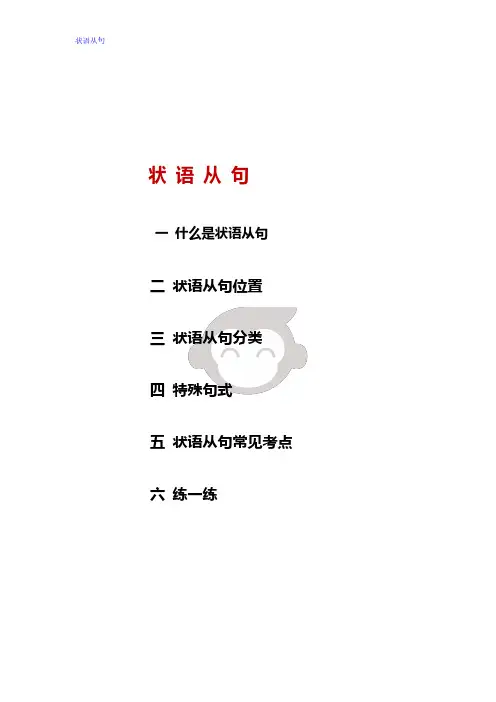
状语从句状语从句一什么是状语从句二状语从句位置三状语从句分类四特殊句式五状语从句常见考点六练一练一什么是状语从句状语从句是行使状语功能的从句,因为其作用相当于副词,它可以用来修饰谓语、定语、状语或整个句子。
状语从句通常由一个连接词或起连接词作用的词组引导。
二状语从句位置比较灵活,有时可以放于句首,有时可以置于句末。
状语从句位于句首时,其后常用逗号与后面的句子隔开。
三状语从句分类状语分类常用连接词例句时间状语after,before,when,while,whenever,as soonas,the moment,as,since,until,the minute,the second,immediately,directly,instantly The ball goes up very high after it hits the ground.Wait until you’re called.地点状语where,wherever You can take a walk wherever you liketo.原因状语Because,as,since,now that,seeing(that)considering(that),Since you do not understand,I will explain again.结果状语so that,such that He is so young that he can’t go to work.目的状语so that,in order that Speak clearly so that they mayunderstand you.条件状语if,unless,as(so)long as,once,unless,on condition that,in case He will do anything as long as it is interesting.让步状语though,although,even though,whilewhether,whoever/no matterwho,whatever/no matter what,whenever/ no matter Even though you say so,I do not believe it.比较状语than as…as,the more…the more The more I see him,the less I like him.方式状语as,as if,as though He told me everything as if I were hisbest friend.四特殊句式1时间状语中A:It+be+时间点+when……当某事发生时是什么时候It was11:00PM when he came back last night.B:It is/has been+时间段+since……自从某事发生后已过了多久时间It is/has been two years since I entered the the senior school.C:It+be+时间段+before……在某事发生之前需要多久时间It was8years before we finally drove away the Japanese invaders.It might be a long time before Chinese land on the moon.2让步状语从句A:as引导的让步状语从句,从句的表语、状语必须前置到句首。
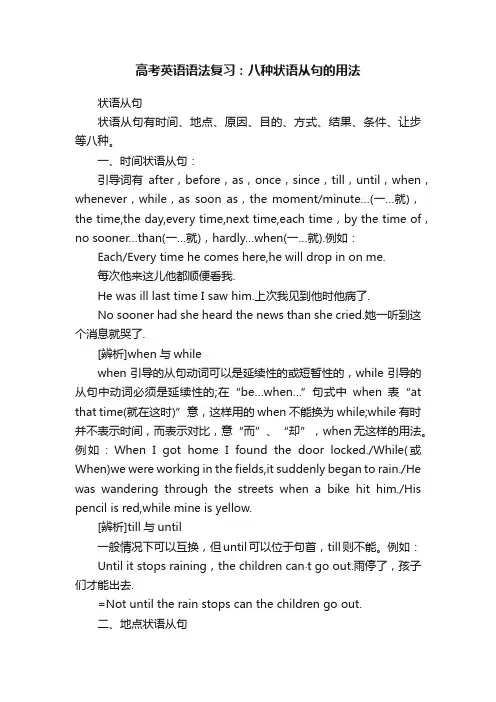
高考英语语法复习:八种状语从句的用法状语从句状语从句有时间、地点、原因、目的、方式、结果、条件、让步等八种。
一、时间状语从句:引导词有after,before,as,once,since,till,until,when,whenever,while,as soon as,the moment/minute…(一…就),the time,the day,every time,next time,each time,by the time of,no sooner…than(一…就),hardly…when(一…就).例如:Each/Every time he comes here,he will drop in on me.每次他来这儿他都顺便看我.He was ill last time I saw him.上次我见到他时他病了.No sooner had she heard the news than she cried.她一听到这个消息就哭了.[辨析]when与whilewhen引导的从句动词可以是延续性的或短暂性的,while引导的从句中动词必须是延续性的;在“be…when…”句式中when表“at that time(就在这时)”意,这样用的when不能换为while;while有时并不表示时间,而表示对比,意“而”、“却”,when无这样的用法。
例如:When I got home I found the door locked./While(或When)we were working in the fields,it suddenly began to rain./He was wandering through the streets when a bike hit him./His pencil is red,while mine is yellow.[辨析]till与until一般情况下可以互换,但until可以位于句首,till则不能。

状语从句那你帮小新造个英文句子吧~~~上面这个句子有什么特点吗?一、状语从句的概念用来修饰主句中的动词,副词和形容词的从句叫状语从句。
时间状语从句地点状语从句条件状语从句目的状语从句状语从句分类原因状语从句结果状语从句方式状语从句比较状语从句让步状语从句1. 时间状语从句4. 只能用as的情况1) as表示“随着……”之意时;2) as表示“一边……一边……”时;3)当表示主从句两个短暂性动作同时发生时。
5. 表示“一……就……”的连词或短语1) as soon as,当主句是一般将来时,从句必须用一般现在时表示将来。
2)在hardly.when/ scarcely.when/ no sooner.than结构中,当hardly/ scarcely/no sooner 放在句首时,主句必须用倒装语序;主句的时态须用过去完成时,从句须用一般过去时。
3) the moment,the minute,the second,the instance后直接接从句。
4) immediately,instantly后直接接从句。
6. every morning,every evening,every time,every day,every year(每……)后直接接从句。
7. “it was+时间点+when从句”it指时间点,时间前无介词,when从句是状语从句;当主句是一般将来时,when 从句用一般现在时。
8. before1)…before.表示“没有来得及做某事就……”,主句经常用过去完成时,从句用一般过去时。
2)“it was(not)十一段时间+before从句(一般过去时)”主句是肯定句时,意为“过多长时间才……”;主句是否定句时,意为“没过多久就……”。
3)“it will be(not)十一段时间十before从句(一般现在时)”主句是一般将来时,从句要用一般现在时表示将来。
9. until1)(not)…until…一肯定句中主句的谓语动词必须是延续性动词;否定句中主句的谓语动词经常是非延续性动词,也可以是延续性动词。

高中英语语法:状语从句知识点状语从句(adverbial clause)在句中作状语,可修饰主句中的动词、形容词和副词等。
状语从句由从属连词引导。
状语从句可放在句首或句末。
放在句首时,从句后面常用逗号;放在句末时,从句前面往往不用逗号。
状语从句根据它们的含义分为时间、地点、原因、目的、结果、方式、让步、条件、比较等九种。
一、时间状语从句1、while, when, whenever和as的用法比较(1)while常表示一段较长的时间或一个过程,强调主句的动词和从句的动词所表示的动作或状态是同时发生的。
它不能表示一时性或短暂的动作。
Don't talk so loud while( as) others are working.别人工作时,请勿大声说话。
(2)when引导的时间状语从句,可指时间的一点,也可以指一段时间,从句的谓语动词可用终止性动词,也可用持续性动词。
when引导的从句表示的具体的时间,从句的动作和主句的动作可以同时,也可以先于主句的动作。
Whenever指任何一个不具体的时间。
It was raining when we arrived. 我们到达时,天正下着雨。
(动作同时,指时间点)When you read the poem a second time, the meaning will become clearer to you.当你再读一遍这首诗,你就更清晰它的含意。
(动作有先后,指时间点,不能用while)Come whenever you like. 你爱什么时候来就什么时候来。
(3)as用as时主句和从句的动作往往同时发生,具有延伸意义,一般同延续性动词连用,有时可译作“一边…一边…”。
As time went on, his theory proved to be correct.随着时间的推移,他的理论被证明是正确的。
As(when)he finished the speech, the audience burst into applause.他讲话结束的时候,听众掌声雷动。
高中英语语法状语从句一、基本概念状语(副词性)副词 动词/句子(形容词/其它副词)介词短语、动词不定式、分词短语、形容词、状语从句分类时间、地点、原因、目的、结果、条件、让步、比较、方式二、分论(一)时间状语从句(1) when 引导的时间状语从句①when 引导的时间状语从句,其动词既可以是延续性动作的动词,也可以是瞬间性动作的动词,而且可以表示主句的动作和从句的动作同时发生,或者从句的动作发生在主句的动作之前。
when you apply for a job, you must present your credentials.当你申请工作时,你必须递交你的有关证件。
(同时)when the students heard the teacher’s footsteps, they all atopped talking.当学生们听到老师的脚步声时,他们都停止了讲话。
(从句动作发生在前) ② when 还可表示just then (正在那时,突然)的意思,此时其所引导的从句只放在主句之后。
be about to do …when … 正要去做某事,突然……be doing …when…正在做某事,突然……be on the point of doing …when…正在做某事,突然……We were about to start when it began to rain.我们正要动身,突然天下起雨来。
The game had hardly/scarcely/barely begun when it started raining.比赛刚刚开始就下起雨来。
(2) as引导的时间状语从句as引导的时间状语从句其动词的动作是延续性的,而且侧重表示主句和从句的动作交替或同时发生,译为“一边……,一边……”或“随着……”We were having breakfast as she was combing her hair.她梳头时我们在吃早饭。
状语从句状语从句在句中作状语,修饰主句中的动词、形容词或副词等,有时修饰整个主句。
状语从句放在主句之前时,常用逗号分开;放在主句之后,一般不用逗号。
状语从句按其意义和作用分为时间、条件、原因、让步、目的、结果、方式、比较、地点等9种。
1. 时间状语从句时间状语从句可放在句首、句中或句尾。
常用when,while,as,after,before,since,until,once,as soon as,the minute / moment“一……就……”,hardly … when,no sooner …than“刚……就……”等连接词引导。
○1连词when,while,as都表示“当……的时候”,但是when引导的从句的动作和主句的动作可以同时发生,也可以先后发生;用as,while时则强调主句和从句的动作同时发生。
如While I was reading, he came in.As he walked along the street, he sang happily.但当从句表示“随时间推移”时,只能用连词as,不能用when或while。
如As time goes on, I like to speak English more and more.○2从属连词as soon as,immediately,directly,the moment,the minute,no sooner … than …,hardly / scarcely … when …,once引导的从句都表示从句的动作一发生,主句的动作随即就发生,意为“一……就……”,从句中用一般时态代替将来时态。
如Once you remember it, you’ll never forget it.The moment I heard the voice, I knew father was coming.No sooner had we arrived at the station than the train left.温馨提示:as soon as,the moment引导的从句表示“一……就……”;no sooner … than …,hardly … when引导的从句表示“刚……就……”。
2024年高中英语语法学习之状语从句精讲英语状语从句是英语学习中的一个重要考点,下面将针对英语状语从句进行考点归纳。
一、时间状语从句时间状语从句是语法中的一个重要考点,下面是一些常见的时间状语从句: when:表示某个时间点或时间段,如“I will arrive at the airport when the plane takes off.”before:表示某个时间点或时间段之前,如“I will eat breakfast before I go to work.”after:表示某个时间点或时间段之后,如“I will finish my homework after I have dinner.”while:表示某个时间点或时间段持续,如“I was studying while she was sleeping.”as soon as:表示某个时间点或时间段一过去就发生,如“I will call you as soon as I get home.”until:表示某个时间点或时间段一直持续,如“I won't leave until I have finished my work.”since:表示某个时间点或时间段以来,如“I have been living in this city since I moved here last year.”when/while/as:这些词都可以引导时间状语从句,但它们的使用略有不同,需要根据具体语境选择使用哪个。
需要注意的是,如果主句是一般将来时,从句只能用一般现在时,如“I will go to the store tomorrow”中的“tomorrow”就是时间状语从句。
二、地点状语从句地点状语从句是语法中的一个重要考点,下面是一些常见的地点状语从句: where:表示某个地点,如“I will go to the store where I bought the groceries.”that:表示某个地点或位置,如“I saw a beautiful sunset over that mountain.”which:表示某个地点或位置,如“The building which is on fire needs to be evacuated immediately.”where/that/which:这些词都可以引导地点状语从句,但它们的使用略有不同,需要根据具体语境选择使用哪个。
高中英语语法:状语从句篇一、时间状语从句1、when的用法(1)when既可引导一个持续性动作,也可引导一个短暂性动作,可用于表示主句和从句动作同时发生或从句动作先于主句动作,有时还可表示从句动作后于主句,意为“当。
时候”。
(2)when在be about to do......when......,be doing.....when.....,had done。
when。
,be on one’s way。
when。
,be on the point of doing。
when。
等结构中,作“那时突然”讲。
(3)when “既然、鉴于;尽管,虽然(位于主句之后);如果”2、while的用法(1)表示“当。
时候”,引导的动作必须是延续性的。
(2)用作并列连词,表示相对关系“然而”。
(3)引导让步状语从句,相当于although,意为“虽然”,位于主句前。
(4)引导条件状语从句,相当于as/so long as,意为“只要”。
3、as 的用法(1)表示“当。
时候”,强调同时发生,不指先后。
(2)说明两种正在发展或变化的情况,表示“随着”,表示时间的推移。
(4)强调两个动作紧接着发生。
(5)表示“虽然,尽管”。
(6)其他含义“正如,正像”,“作为”,“由于,因为”。
4、before的用法(1)一般意为“在。
之前”“。
才”,“。
就”“还没有。
”“免得”“不知不觉”“宁可,宁愿”,“否则,要不然”。
(2)It + will be/was + 时间段+before+一般现在时/一般过去时。
在肯定句中,意为“多长时间之后才”;在否定句中,意为“用不了多长时间就”。
5、until和till(1)与肯定句连用,必须是延续性动词。
(2)与否定句连用,必须是非延续性动词,表示“直到。
才,在。
之前不。
”。
注意:not until可用于强调句和倒装句强调句:It is/was not until…that…倒装句:not until 放句首时,主句要部分倒装。
状语从句一.分类:adv.+that(如此……以致)so that(结果……)such+n.+that(如果……以致)that(所以,因此)让步状语从句:though/although不可同but连用。
though/although (虽然)however (可是)even though/if(即使)no matter+what/which/where/who/when =whatever/whichever/wherever/whoever/whenever.(不论什么/哪一个/哪里/谁/何时)比较状语从句:as (正如)as…as(和……一样)not as/so … as (不如……)than(比……更)the+比较级…+the+比较级(越……越……)条件状语从句:if(假设)unless(如果不)so long as(只要)on condition that (如果)方式状语从句:as(像……那样地)just as(正像)as if(好像)as though(好像)二.各种状语从句的简化方法:1作状语。
%例:After she sang,she left the rich man's house.= After singing,she left the rich man's house.2.以as soon as引导的状语从句的主语若与主句主语一致时,从句等于on+doing sth.,作状语,此时的动词为非延续性动词。
例:Mary began to operate on the wounded soldiers as soon as he arrived at the village.= Mary began to operate on the wounded soldiers on arriving at the village.3.时间状语从句和条件状语从句的主语和主句主语一致时,有时可简化为不定式作状语。